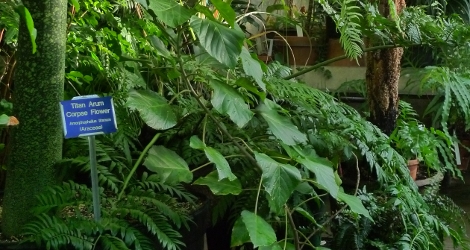Accession Data:
Crocus sativus L.
- Common Name: Saffron Crocus
- Family: Iridaceae Juss.
- Country of Origin: unknown in the wild
- Description: Unknown in the wild, Saffron has been suggested to originate from western or central Asia among other places. Since it has been cultivated by humans for over 3500 years, it is likely that the genetics of saffron have mixed origins. It is currently grown throughout the Mediterranean region and parts of Asia.
- Uses: To collect the saffron, pick the stigmas as soon as the flowers open, before the flower has a chance to wilt. Air dry the stigmas as quickly as possible and store in a closed container away from light or heat. The stigmas are valued for both the yellow dye that can be made from them, and the cooking spice. Saffron is considered one of the most expensive spices in the world because the best way to collect the stigmas is through handpicking. Due to the lack of mechanization of this process, labor costs increase the cost of the spice. In 1998 saffron prices rose to $8.50 per gram in the United States.
Accession Data:
- Accession # 201800053
- Source: Jason Lopez - University of Washington
- Accession Date: 08-06-2018
- Bench: 2101 - MED:Mediterranean A
- Currently: active - healthy
- Qty: 1 confirmed on 01-02-2025
Classification:
- Division: Magnoliophyta
- Class: Liliopsida
- SubClass: monocots
- Order: Asparagales
- SubOrder:
- Family: Iridaceae
- SubFamily: Crocoideae
- Tribe:
- SubTribe:
References (internal):
References (external):
- The Plant List (2013). Version 1.1. Last accessed on Monday, August 06, 2018.
- Crocus sativus at WikiSpecies. Last accessed on Monday, August 06, 2018.
- Crocus sativus at ARS-GRIN. Last accessed on Monday, August 06, 2018.
data regenerated on Sat, 10 May 2025 13:44:31 -0400 [bcm v4.0]
Images:

Additional images for this accession:
Click on thumbnails to enlargeCurrent Accessions in the Iridaceae
Subfamily Aristeoideae
Subfamily Crocoideae
Subfamily Crocoideae
Tribe Gladioleae
Subfamily Crocoideae
Tribe Ixieae
Subfamily Iridoideae
Tribe Irideae
Subfamily Iridoideae
Tribe Sisyrinchieae
Subfamily Iridoideae
Tribe Trimezieae
Subfamily Ixioideae
Tribe Freesieae
- Freesia alba


- Freesia fucata W/C
- Freesia laxa

- Freesia occidentalis
- Freesia refracta W/C
- Freesia unidentified

Subfamily Ixioideae
Tribe Ixieae
Subfamily Ixioideae
Tribe Watsonieae
W/C = Wild Collected
 = indicates flowering in past 14 days
= indicates flowering in past 14 days
 = images available for this accession
= images available for this accession
 = map available for this accession
= map available for this accession
 = accession added within past 90 days
= accession added within past 90 days